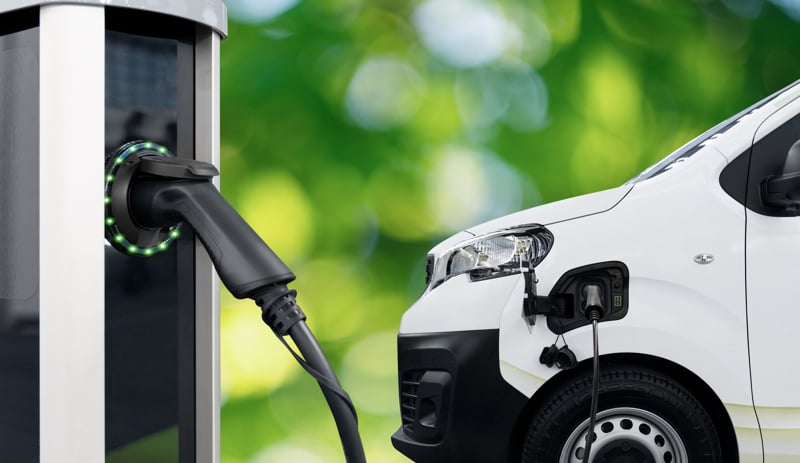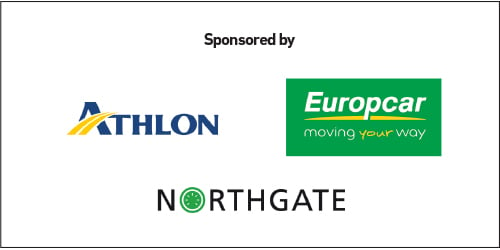This feature was taken from our Electric Fleet: Moving to Net Zero special report.

While the adoption of battery electric vehicles as company cars is racing ahead, the take-up of electric vans has been left trailing in their wake.
“The red light is flashing really hard and bright on the electric van market,” says Toby Poston, director of corporate affairs at the British Vehicle Rental & Leasing Association.
“Registrations this year are down on last year which I don’t think anyone really expected, and certainly are not where they’ve got to be.
“There are continued issues with the functionality of these vehicles, their cost of ownership, competitiveness and charging.
“Van operators are still quite disappointed with the lack of accessibility to some charging sites, that they can’t book spaces for charging and that a lot of the charging infrastructure is the really high-speed, ultra-rapid chargers which vans don’t have the functionality to use.”
Society of Motor Manufacturers and Traders figures for August show that electric van registrations have fallen 21.5% compared with the same month last year, with only 881 units sold against 1,122 units 12 months ago.
It was the third successive month of decline and represents a monthly market share of 5.3%, well below the ZEV Mandate’s headline target of 10% (see page 6) for 2024.
“We are quite early on in the impact of the mandate, however it seems obvious already that the early years’ targets for electric vans will have to be revised because, although it states lower quotas for vans than for cars, what it doesn’t take into account is the pace at which electric vans will be taken into fleets,” says Simon Staton, client management director at Venson Automotive Solutions.
“The challenge for fleet operations is that an electric van doesn’t always fit their fleet. Factors such as the payload, mileage and charging infrastructure mean that an electric van currently can’t aways meet the operational requirements for the organisation without a lot of planning and negotiation with the business – and sometimes unions – with regard to changes to operational ways of working.”
Regulatory issues
Layered on top of this are the regulatory aspects of managing an electric van, he adds. There is much frustration in the fleet sector that, due to the weight of their batteries, larger electric vans have become entangled in multiple rules and regulations originally intended for the heavy goods vehicle sector.
Industry bodies have repeatedly asked for clarification on whether heavier electric vans on the 4.25-tonne derogation require a tachograph and 60mph speed limiter, whether driver hour rules apply, and which drivers require a Certificate of Professional Competence (CPC) qualification, he adds.
“There has been some movement,” says Staton. “For instance, most professional drivers who passed their driving test after January 1, 1997, used to need 35 hours of additional training to drive alternate fuel vehicles in excess of 3.5 tonnes.
“Since 2019, an exemption has been in place – the fabled gross vehicle weight (gvw) derogation has enabled those with a Category B passenger car licence to drive 4.25-tonne electric vans after taking a reduced amount of additional training, just five hours.”
This is still proving an obstacle for fleets and the Government announced in October last year that this additional training requirement would be removed for electric vans weighing up to 4.25t.
It also promised to make changes to towing allowances and broaden the flexibility to cover all vehicle types, beyond goods vans, recognising that further measures were needed to support their uptake.
However, legislation required to change the rules has not yet been introduced, although during the summer Abdul Chowdhury, head of vehicle policy at the Office for Zero Emission Vehicles, told the Fleet200 Strategy Network he expected the changes to be legislated by the end of this year.
Charging challenges
A further issue is charging. “If you have a depot or an area to store your vans overnight where you can charge your vans, it’s a lot less challenging,” says Rob Simister, director – fleet operations at Centrica.
“If you have to take the van home to charge, then it has to take up a driveway space. So where do you put your personal car? Does that affect your insurance because that may be insured to park on your drive?
“What if you’ve got other electric cars? Will it be the work vehicle which gets charged, or is it the car that is used to take the children to school in the morning?
“Our biggest challenge with electric commercial vehicles is productivity. If you cannot charge the vehicle overnight then you’re introducing additional downtime which, if you run a business, costs money.”
If a driver is not able to charge at a depot or at home overnight, they will need to use the public charging network. This has specific issues for commercial vehicle operators.
The current issue is not around the number of charge points available: latest figures from the Department for Transport show there were 64,632 public charging devices installed in the UK on July 1, an increase of 47% on the same date last year.
But it is about access to them for commercial vehicles.
“The infrastructure is there for the amount of EVs we have at the moment,” says Lorna McAtear, head of fleet at National Grid. “But there is an issue with space around the chargers and that really does need to be considered.”
Key considerations
A number of factors need to be taken into consideration to ensure the successful integration of electric vans into fleet operations, says Pat Skelly, CEO of Prohire.
These include the nature of the organisation’s business, payload requirement, driver behaviour, charging needs, location and where the vehicles are parked overnight.
Confidence in the technology is also important. Organisations who are unfamiliar with e-vans may be deterred from taking them on if, for example, they feel they cannot trust them as their real-world range does not match WLTP figures.
“You do wonder why we get hung up about WLTP,” says Matt Hammond, head of fleet at Altrad UK. “Nobody believed the official mpg figures before, so why did we suddenly believe WLTP for electric vehicles was right?
“Towing or having a load on the back can have a massive impact, so you’ve got to use the worst-case scenario to plan from.
“You’ve got to ignore what’s on paper. Do your own research. Talk to other fleets who have done it and listen to them. Those guys have the data you need.”
There are also driver wellbeing benefits as the electric vans are quieter and smoother to drive. “Almost to a man everyone loves driving our electric vans,” says Colin Hutt, fleet manager at Clarion Response.
“From my experience they also seem to have fewer issues in terms of service and maintenance, particularly in and around London; you don’t get DPF (diesel particulate filter) issues, for example.”
McAtear adds: “We’ve had an uptick in well-being because they drive better. We’ve also had fewer incidents in those vehicles.”
However, while the current picture may appear bleak, hundreds of organisations are using electric vans with great success, to improve their environmental performance as well as – in many cases – reducing operating costs.
“With the right vehicles, right pricing and a clear, workable strategy from the Government that addresses the regulatory aspects of managing a light commercial fleet, the UK e-van market could improve in the medium-to-long term,” says Staton.
“Overall, right now, however there’s no hiding the fact that the picture is far from rosy.”
Decarbonising a fleet is not just about replacing an ICE vehicle with a like-for-like electric replacement – it may open the door to other, more operationally efficient transport modes.
In our new Electric Fleet: Moving to Net Zero special report, we look at the fleets that are already utilising flying drones, rolling robots or powered mobility such as e-cargo bikes and light vehicles, assessing use cases and considerations for organisations looking to pilot these options.
We also look ahead to forthcoming battery electric technology to evaluate its potential impact on fleet operations, with longer ranges and faster charging among the key benefits, as well as the potential of hydrogen, which is undergoing a number of Government-funded trials in the UK.
Other topics we investigate include the ongoing impact of the ZEV Mandate and how fleet managers need to be prepared to take advantage of any potential deals offered by manufacturers, and technology trends – including batteries – which will have an influence on fleet operations.
We also look at what fully-electric cars will hit the UK market over the next 12 to 18 months, some of which will offer a WLTP range of more than 400 miles.






















Login to comment
Comments
No comments have been made yet.